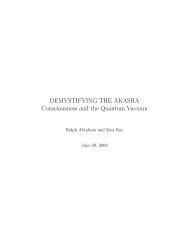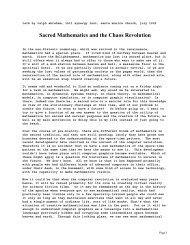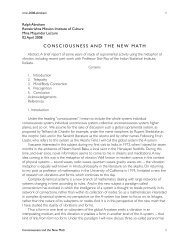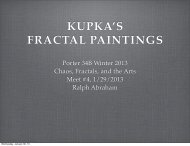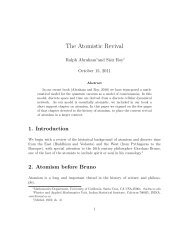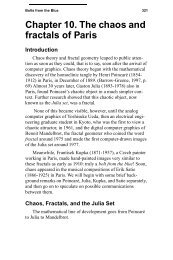BOLTS from the BLUE - Ralph Abraham
BOLTS from the BLUE - Ralph Abraham
BOLTS from the BLUE - Ralph Abraham
Create successful ePaper yourself
Turn your PDF publications into a flip-book with our unique Google optimized e-Paper software.
Bolts <strong>from</strong> <strong>the</strong> Blue<br />
3<br />
The sequence of five stages<br />
In <strong>the</strong> l960s and 70s, William Irwin Thompson joined anthropology,<br />
artistic studies, and political history into a unique approach<br />
to cultural history. 6 He intuitively made use of <strong>the</strong> ideas of dynamical<br />
historiography to parse our whole history into plateaus punctuated by<br />
major shifts.<br />
In his Pacific Shift of 1985, he described four major stages in<br />
<strong>the</strong> history of <strong>the</strong> West: <strong>the</strong> Riverine, Mediterranean, Atlantic, and<br />
Pacific-Space stages. 7 The approximate dates for <strong>the</strong> major bifurcations<br />
separating <strong>the</strong>m (and <strong>the</strong>ir chief characteristic features) are:<br />
• Tl. Beginning of Riverine: 4000 BCE 8 (writing)<br />
• T2. Riverine to Mediterranean: 2000 BCE (alphabet)<br />
• T3. Mediterranean to Atlantic: 1500 CE (printing)<br />
• T4. Atlantic to Pacific-Space: 2000 CE (computer)<br />
The Riverine refers to <strong>the</strong> cultural ecology of <strong>the</strong> Indus, Nile,<br />
and Mesopotamian valleys. The Mediterranean is <strong>the</strong> cultural ecology<br />
all around <strong>the</strong> Mediterranean Sea. The Atlantic includes Western<br />
Europe and Eastern North America, in particular. And <strong>the</strong> Pacific<br />
cultural ecology is that currently emerging around <strong>the</strong> Pacific Rim.<br />
Hence his title, Pacific Shift. We are now in <strong>the</strong> midst of a major<br />
bifurcation (a tipping point) <strong>from</strong> <strong>the</strong> Atlantic to <strong>the</strong> Pacific cultural<br />
ecology.<br />
Independently, in my Chaos, Gaia, and Eros of 1994, I presented<br />
world cultural history in four epochs, divided by three major<br />
bifurcations:<br />
• Al. Paleolithic to Neolithic: 10,000 BCE (agriculture)<br />
• A2. History: 4000 BCE (writing)<br />
• A3. Chaos: 2000 CE (computational math)<br />
6 See (Thompson, 1967) and (Thompson, l97l).<br />
7 Developed in a talk on February 13, l983. See (Thompson, 1985, esp. Ch.<br />
4).<br />
8 ln this book we use BCE and CE in place of BC and AD for dates before<br />
and after <strong>the</strong> time of <strong>the</strong> Christ.




